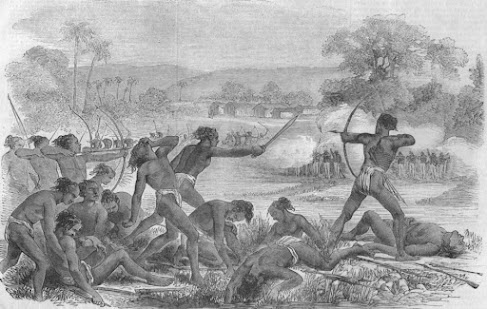Santhal Rebellion -1855
The first people to raise their voice against the British in India were not the people of this country’s rich or educated class, but people belonging to the forest dwellers or tribal community of this country. One such tribal rebellion ‘Santhal rebellion’ has great importance in history.
 |
| A symbolic picture of the Santhal rebellion-photo credit wikipedia |
Where did the Santhal rebellion take place?
The rebellion of the Santhals was the most powerful among the revolts of the tribals. The area between Bhagalpur to Rajmahal was known as ‘Daman-i-Koh’. This area was a Santhal tribal dominated area. Thousands of Santhals organized organized rebellion here. The Santhal rebels waged a vigorous struggle to expel the non-tribals, abolish their power and establish their power.
What were the reasons for the Santhal rebellion?
What were the socio-economic reasons due to which the Santhals became rebellious. It has been described by a writer of that time, which was published in ‘Calcutta Review’ which is as follows :—
“The zamindars of this region, the English police, the government revenue department and the British courts committed inhuman atrocities on the Santhals. Their property was snatched away. The Santhals were humiliated and beaten up at every step. The Santhals were given loans at the rate of 50 to 500 per cent. Interest was charged. Rich and powerful people, whenever it came to mind, ravaged the toiling Santhals. Elephants were driven over their standing crops. Such atrocities became common. Diku (non-tribal) and Government servants were also tyrants in the eyes of the Santhals. These people used to force the Santhals to do forced labor. Stealing, lying and drinking had become a habit.”
Beginning of Santhal Rebellion
By the time of 1854, the tribal people had started swearing to raise their voice against the atrocities against them. The chiefs of the tribals started holding Majlis and Parganit meetings and preparations started for open rebellion.
Sporadic incidents of looting of landlords and usurers started.
“On 30 June 1855, the Santhals gathered around 6000 tribal representatives from 400 tribal (Santhal majority) villages at Bhagnidih and held a community meeting. All of them decided with the consent that by exterminating the outsiders, ending the rule of foreigners forever, the rule of Satyug and religion was done. But there should be open rebellion to establish his rule.
Who was the leader of the Santhal rebellion
The Santhal people believed that God was with them. The two prominent leaders of the rebel Santhals were Sido and Kanhu. Both these leaders announced that Thakurji (God) had instructed them to take up arms for freedom. Sido told the officers,
“Thakurji (God) has given me a clear order saying that this country (India) does not belong to sahabs (British).. Thakur ji himself will fight on our side. In this way you sahib people and sepoys will fight with sahib himself.
Action of Santhal rebels
These tribals took out processions in the village. Playing ‘dhol’ and drums, these men would call upon the women to fight. He made everyone ready to fight. The Santhal leaders used to walk on elephants, horses and palanquins. Very soon he gathered around 60,000 armed Santhals. In addition, several thousand tribals were asked to remain prepared. He was told to pick up the weapon when the drum beats. The rebels started attacking the Mahjans and Zamindars. A group of Santhal rebels set fire to the houses of landlords and usurers.. Police stations, railway stations and postal washing vehicles were burnt. Almost everything that was attacked was the means of exploitation of diku (non-tribal) and colonial power.
Suppression of Santhal Rebellion by British Government / Who suppressed the Santhal rebellion?
This organized rebellion of the Santhals astonished the British government. And the colonial government took the help of the army to deal with this rebellion. To eliminate the rebels, 10 units were sent under the leadership of a Major General (General Laid). Martial law was enforced in the insurgency affected areas and a reward of Rs 10,000 was announced for capturing the rebel leaders.
Consequences of Santhal Rebellion
The tyranny and use of force of the autocratic and powerful power crushed this rebellion. More than 15 thousand Santhal rebels were killed in the action of the British government. The villages of the Santhals were completely destroyed.
In August 1955, Seido was arrested, Seido was executed. Kanhu was caught in February 1886. The hills of the palace turned red with the blood of the Santhals.
Ale. s. s. O. Mulay has described the rebellion of the Santhals as encounter and described their bravery in some of these words :—–
“The Santhals showed indomitable courage to the whole country and the world, despite the unbearable torture, the Santhals did not give up in front of the tyrannical British army and police. Once 45 Santhals were hiding in a hut. The soldiers were surrounded by them. Whenever the soldiers fired, these Santhals shot arrows. When their arrows missed the target. When they went, the soldiers entered the hut. Only one old Santhal was alive in the hut. When a soldier asked him to surrender, he rushed to attack the old Santhal soldier and cut the soldier into pieces with his axe.
Thus the Santhal rebellion may have been suppressed by the colonial government, but its threat continued to be heard for many years to come. The struggle of these tribals later gave birth to the revolutionary movement.